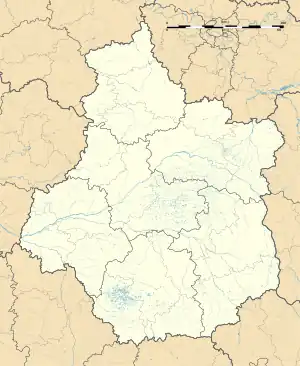Saint-Lyé-la-Forêt
Saint-Lyé-la-Forêt (French pronunciation: [sɛ̃ lje la fɔʁɛ]) is a commune in the Loiret department in north-central France.[3]
Saint-Lyé-la-Forêt | |
|---|---|
.svg.png.webp) Coat of arms | |
Location of Saint-Lyé-la-Forêt | |
 Saint-Lyé-la-Forêt  Saint-Lyé-la-Forêt | |
| Coordinates: 48°02′27″N 1°58′58″E | |
| Country | France |
| Region | Centre-Val de Loire |
| Department | Loiret |
| Arrondissement | Orléans |
| Canton | Pithiviers |
| Intercommunality | La Forêt |
| Government | |
| • Mayor (2020–2026) | Jacques Christian Van Belle[1] |
| Area 1 | 27.22 km2 (10.51 sq mi) |
| Population | 1,216 |
| • Density | 45/km2 (120/sq mi) |
| Time zone | UTC+01:00 (CET) |
| • Summer (DST) | UTC+02:00 (CEST) |
| INSEE/Postal code | 45289 /45170 |
| Elevation | 120–137 m (394–449 ft) (avg. 127 m or 417 ft) |
| 1 French Land Register data, which excludes lakes, ponds, glaciers > 1 km2 (0.386 sq mi or 247 acres) and river estuaries. | |
History
Saint-Lyé-la-Forêt takes it name from Saint Lyé, a hermit who had retired to the forest seeking solitude. It was there that he began to work miracles: he healed the sick of their infirmities, especially children. He died in 534.[4]
A chapel was erected on his tomb on the site of the current church. Later, his relics were transported to Pithiviers, but burned by the Huguenots in 1580. The remains preserved by Christians from Pithiviers were brought back to the village in 1664 after many adventures. They rest in a reliquary placed at the foot of the altar dedicated to him in the village Church of Saint Roch.[5]
The village is near the site of an ancient road from Orléans to Paris. In 1918, Saint-Lyé became Saint-Lyé la Forêt.
Chateau de la Mothe
It is reported that during the Crusades, Simon de Bombelle having saved Saint-Louis by covering him with his shield, the king gave him, on his return to France, around 1273, the barony of Mothe-Saint-Lyé which remained in this family. for three centuries.[5]
The earliest part of the chateau dates back to the 16th century. The building, with a central staircase, sits at the end of a main courtyard surrounded by a moat bordering the castle.[6] The Mansard roof is flanked by two turrets. The facades and roofs of the castle, courtyard and moat are registered as historical.
See also
References
- "Répertoire national des élus: les maires". data.gouv.fr, Plateforme ouverte des données publiques françaises (in French). 2 December 2020.
- "Populations légales 2020". The National Institute of Statistics and Economic Studies. 29 December 2022.
- INSEE commune file
- "Saint Lié", Nominis
- "Histoire de St Lyé", Saint-Lyé-la-Forêt
- "Château de la Mothe", Ministère de la culture